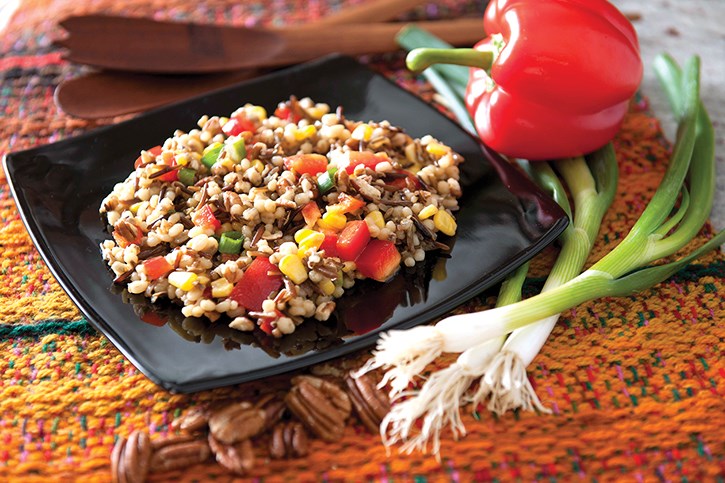In ancient Rome, gladiators ate so much barley to improve their odds that they were also known as hordearii — barley men.
Barley seems to have had few champions since then.
Enter Linda Whitworth into the arena. The market development manager for Alberta Barley not only launched GoBarley.com last year, she’s now helped compile a book of 109 recipes called Go Barley: Modern Recipes for an Ancient Grain. (And no, its subhead isn’t “109 variations of beef and barley soup.”)
No offence to quinoa, the current darling of the ancient grain world, but barley’s documented lineage goes back 10,000 years compared to quinoa’s 7,000. Most of the world’s quinoa is imported from Peru and Bolivia but, here in Canada, Alberta produces half of our barley crop. Of that, 80 per cent is used to feed livestock, creating the white marbling that makes Alberta beef so highly prized, 19 per cent is used for malt by beer makers and one per cent enters the human food chain.
Where quinoa has barley beat is on gluten-free diets. Barley, which is low in gluten, is safe for people with wheat sensitivities but not people who are celiac.
In 2012, the Canadian government gave barley “superfood” status. While it’s missing two of the amino acids that make quinoa a complete protein, if you add beans to a barley dish, your protein needs are met.
One local chef who needs no convincing that barley deserves a place on his menu is Pino Posteraro, the owner of Cioppino’s Mediterranean Grill in Yaletown (and Vancouver magazine’s 2014 Chef of the Year.)
“It marries beautifully with beans,” he said at a recent dinner with Whitworth that featured two barley-inspired appetizers: barley with fermented cabbage, green chick peas and sidestripe shrimp that he’d pounded with a mortar; and then barley with pork belly and watercress.
The barley has a perfect Goldilocks consistency — neither too crunchy nor too mushy. (Posteraro suggests blanching the barley in vegetable stock first.) Whether it is providing the foundation for the more refined nuances of the shrimp or the comfort-food heartiness of the pork belly, the barley somehow manages to both meld into the background and play a starring role.
In Italian cuisine, barley is called orzo, not to be confused with the rice-shaped orzo pasta, and parents who don’t want caffeinated children often offer them caffeine-free caffe d’orzo, made with roasted barley. When Posteraro suggests barley with maple syrup, cinnamon and apple sauce as a breakfast option, Whitworth adds that for sweet dishes you can cook the barley with fruit juice instead of water.
Joining Whitworth at the dinner is Craig Stowe, the founder of the Chinese Restaurant Awards Whitworth’s goal is to introduce more Alberta barley into Chinese cuisine and they talk about the possibility of using barley instead of rice to make congee.
Barley has the lowest glycemic index of all the cereal grains and, as a result, “you don’t get those insulin spikes,” says Whitworth, a trained home economist. Not only is it a healthier choice for diabetics, it lowers cholesterol, too, and because of its higher fibre content, keeps you feeling full longer.
As China becomes a more affluent country, problems with diabetes and obesity are on the rise, making Alberta’s barley growers feeling optimistic that they can make more inroads into Asian cuisine.
“Barley’s always been the bridesmaid,” Whitworth says. Her quest is to make everyone realize it’s time to say, “I do.”
Asian Barley and Wild Rice Salad
2 cups (500 mL) chopped pecans
1 cup (250 mL) wild rice
4 cups (1 L) chicken or vegetable broth, or water
1 cup (250 mL) pot or pearl barley
2 medium sweet red peppers, chopped
1/4 cup (60 mL) chopped green onions
2 cups (500 mL) frozen corn kernels, thawed
1/3 cup (75 mL) soy sauce
1/3 cup (75 mL) rice vinegar
1/4 cup (60 mL) sesame oil
Preheat oven to 350°F (180°C). On an ungreased baking pan, spread pecan pieces evenly. Bake for 5 minutes. In a large saucepan over high heat, bring wild rice and broth or water to a boil. Reduce heat and simmer for 15 to 20 minutes. Add barley and continue simmering for an additional 40 minutes. Cover pan and let stand until all moisture is absorbed. Cool
Put barley mixture in a large serving bowl. Add peppers, onions, corn, soy sauce, rice vinegar, and sesame oil; mix well. Place in fridge for 2 hours or overnight. Add pecans just before serving.
Makes approximately 12 servings.
Nutritional Information (per serving): Calories: 312, Protein: 7 g, Carbohydrate: 32 g, Fiber: 6 g, Sugars: 4 g, Fat: 18 g, Saturated Fat: 2 g, Trans Fat: 0 g, Cholesterol: 0 mg, Sodium: 719 mg, Potassium: 291 mg
The recipe above is from Go Barley. To win a copy of the cookbook, go to WEVancouver.com/contests.



